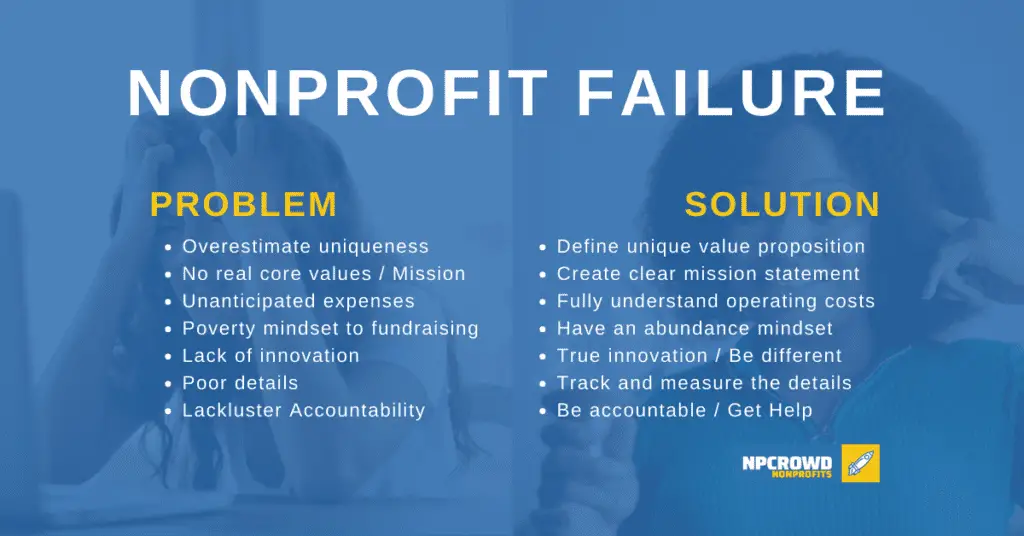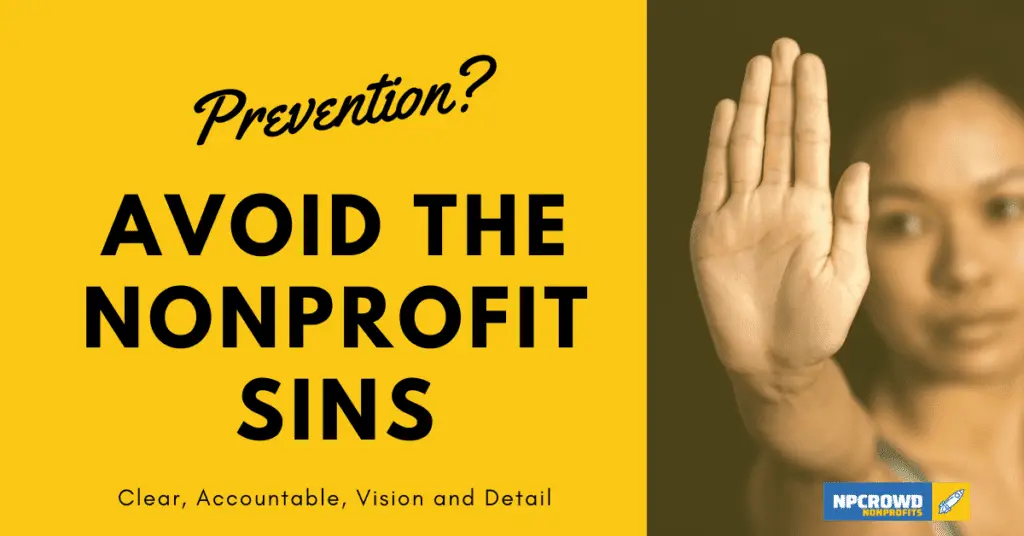7 Deadly Sins of Nonprofit Failure And How To Avoid Them
Disclaimer: This post may contain affiliate links. These links, if used and purchases made, we may earn a small commission. These affiliate programs do not impact the recommendations we make or the resources we refer you to. Our focus is on providing you the best resources for your nonprofit journey.
As small businesses, nonprofits have a high rate of failure. Over 44% of all small businesses fail in the first 5 years. 30% of nonprofits fail to exist after 10 yearsBut why?
According to the Concord Leadership Group:
- 49% of nonprofits are operating without a strategic plan
- 67% of nonprofit CEOs report not planning on being in their position in five years
- CEOs are taking nonprofit positions without all the experience needed to successfully run the organization. The need to fundraise is surprising.
Ouch! Is that really true? Then what can you do to protect the longevity of your nonprofit organization? What is nonprofit failure?
Let’s look at the 7 most common causes of nonprofit failure and how you can avoid them.
The 7 Deadly Sins Of Nonprofit Failure
Nonprofit failure is the shutting down of a nonprofit organization. It can happen due to a lack of funds, donors, or volunteers. It can also be due to mismanagement, or a lack of a clear mission or purpose.
Why does nonprofit failure matter? Nonprofit failure matters because when a nonprofit shuts down, it can mean that the people who need the services the nonprofit provides will no longer have access to them. Nonprofit failure can also have a ripple effect on the community, as the loss of jobs and volunteer opportunities can impact the local economy.
1. Underestimating competition and value proposition
One of the most common deadly sins preventing nonprofit success is underestimating the competition and your value proposition. In order to be successful, it is essential that you understand the competitive landscape and develop a clear and compelling value proposition.
Your value proposition is what sets you apart from other organizations and tells potential donors why they should support you. It should be clear, concise, and easy to understand. Take the time to develop a strong value proposition, and make sure that it is communicated effectively to your target audience. You may “think” your nonprofit is unique, but is it really?
Over-estimating a nonprofit’s uniqueness makes it just another nonprofit doing the same things for the same reasons as other nonprofits in the space. That’s certainly not inspiring. Worse yet, those other nonprofits are already known. They have clients and donors. A new nonprofit hardly stands a chance, despite good intentions.
2. Losing your way without core values and a singular mission
One of the most common reasons that nonprofits fail is because they lose sight of their core values and mission. Without a clear sense of purpose, it can be easy to get sidetracked and end up doing things that are not in line with the original goals of the organization. This can lead to a loss of support from donors and other stakeholders, and ultimately, to the failure of the nonprofit.
This problem happens more than you might think. One study found that nearly 60 percent of nonprofits surveyed had “significant confusion” about their mission. This is a serious problem because, without a clear mission, it’s very difficult to achieve anything. Just because the Founder knows the mission doesn’t mean everyone else does.
3. Failure to understand operating costs
One of the most common reasons that nonprofits fail is because they underestimate their total operating costs. It’s not enough to just have a good idea – you need to be able to execute it in a way that is sustainable. This means having a clear understanding of your organization’s operating costs so that you can plan accordingly.
Failing to fully understand the total costs of operating a nonprofit can lead to a number of problems down the road. For one, it can make it difficult to fundraise effectively since you won’t know how much money you actually need to raise. Additionally, it can lead to financial problems down the road as unexpected costs pop up.
We’re not talking about nonprofit startup costs, but the true operating expenses of the organization on a year-to-year basis.
Without a financial cushion, operating reserves, an unexpected expense or the loss of a significant donor can single-handedly cause a nonprofit to close its doors permanently.
A quick refresher on the financial plan from our quick nonprofit business plan article may help.

4. Scarcity mindset leads to a lack of meaningful asks of donors
One of the most common causes of nonprofit failure is a scarcity/poverty mindset, which leads to a lack of meaningful asks of donors. This lack of meaningful asks can be crippling to a nonprofit, as it can prevent the organization from raising the funds it needs to survive, let alone grow and sustain its impact.
This lack of meaningful asks is often the result of a fear of rejection, as many nonprofits believe that donors will not be willing to give if they are asked for too much. However, this is not the case, as most donors are more than happy to give if they know that their money is going to a good cause. At the same time, this meekness robs donors of potentially meaningful contributions that build strong relational ties and prevents advocacy activities.
Therefore, it is important for nonprofits to overcome their fear of rejection and start asking for more from their donors. If they do not, they will likely find themselves struggling to survive.
5. Copying rather than innovating
One of the quickest ways to kill a nonprofit is by failing to innovate. In today’s world, nonprofits must constantly be on the lookout for new and better ways to do things in order to stay relevant. This means being open to change and willing to experiment with new ideas. When a nonprofit fails to innovate, it not only falls behind the competition but also loses the support of donors and other stakeholders.
This lack of innovation is seen when a nonprofit simply does what other nonprofits in the market are doing. The same programs, the same fundraising strategies, the same everything. This is a surefire recipe for disaster, as it not only fails to stand out from the competition but also fails to address the needs of the community it serves.
In order to avoid this deadly sin, nonprofits must be willing to take risks and try new things. This means being open to change, even if it means stepping outside of their comfort zone. It also means being willing to fail, as not every experiment will be a success. But by constantly innovating, nonprofits will be able to stay ahead of the curve and continue to make a difference in their communities.
6. Losing track of the details
Nonprofits can fail because they lose track of the details. This can manifest in a number of ways, but often it means that the nonprofit stops paying attention to its finances, its programs, or its internal processes at a detailed level. This can be devastating for a nonprofit because it can quickly lead to a loss of donors, a loss of funding, or even a complete shutdown. How can a lack of detail lead to a nonprofit shutting its doors? There are a few examples.
First, if a nonprofit isn’t paying attention to its finances, it can quickly find itself in debt. This can be especially true if the nonprofit is relying on donations or grants to fund its operations. Maybe it is a situation where thank you letters, receipts, and acknowledgments are being missed or not sent in a timely fashion.
If donors or grantors stop giving, the nonprofit will have to find another way to fund its operations, and if it can’t, it will have to shut down.
Second, a nonprofit that isn’t paying attention to its programs can quickly find that they are ineffective or even harmful. This can lead to a loss of funding as well as a loss of support from the community. Think about safety steps that are not monitored. How quickly could a mishap or injury lead to a lawsuit that bankrupts an unprepared organization?
If a nonprofit’s programs are not having the intended effect or are causing harm, it is unlikely to be able to continue operating.
Finally, a nonprofit that is not paying attention to its internal processes can find itself in disarray. This can lead to a loss of efficiency and, ultimately, a loss of support from staff, volunteers, and the community.
If a nonprofit cannot function effectively, it is unlikely to be able to continue operating. Losing track of the details can be deadly for a nonprofit. If you want your nonprofit to thrive, it is essential that you pay attention to the details.
7. Lackluster Accountability
One of the most common reasons that nonprofits fail is due to lackluster accountability. Without accountability, it is difficult to track progress, set goals, and measure success. This can lead to a downward spiral of decline for the organization. There are a few key ways to avoid this deadly sin.
First, it is important to set clear and measurable goals. This will help to hold everyone in the organization accountable to meeting those goals.
Second, regular communication is key. Make sure to keep everyone in the loop on progress, setbacks, and changes. This will help to keep everyone on the same page and working towards the same objectives.
Finally, be willing to make changes. If something isn’t working, don’t be afraid to pivot and try something new. Accountability is essential for any organization, but especially for nonprofits. Without it, it is difficult to track progress, set goals, and measure success. This can quickly lead to a decline in the organization.
By setting clear goals, communicating regularly, and being willing to make changes, nonprofits can avoid this deadly sin and set themselves up for success.
How To Avoid The Deadly Sins That Sink Nonprofits

Define your unique value proposition
Before starting your nonprofit, make sure you have a clear understanding of your unique value proposition – what makes your nonprofit different from all of the others out there? This will help you stand out from the competition and attract donors.
It is natural to think that your organization will be different than the rest. But thinking isn’t going to make it different. Write down your unique value proposition. How will your organization be different in what it delivers and the impact of its operations? Then get 3 people that will poke holes in that value proposition. The more they poke holes, the better your differentiators will become because it forces you to think through the details.
Create a clear and concise mission statement
Your nonprofit’s mission statement should be clear and concise, and it should guide all of your actions. This mission should be based on your organization’s core values.
So, identify those “holy grail” values that will serve as the bedrock for your organization. Every decision, direction, action, service, and employee action will be filtered through the values. The clearer the values, the easier it will be for the people in the organization to make decisions that are in line with the mission.
Understand your operating costs
One of the most important things you can do when starting a nonprofit is to understand your operating costs. This includes everything from staff salaries to office space to program costs. Make sure you have a clear understanding of all of the expenses associated with running your nonprofit before you start asking for donations.
The best way to get a clear picture of your total operating costs is to sit down and create a budget. This will help you determine how much money you need to raise and where you can cut costs if necessary. Get a banker friend or a business owner to review the budget and income projections looking for things you missed.
What about insurance costs, website hosting, office equipment, marketing expenses, and other random things that come up? Add a line item for “unexpected expenses” and put 10% of what you think everything will cost in that line item.
Once you have a clear understanding of your operating costs, you can start to look for ways to reduce them. One way to do this is to look for ways to increase efficiency and cut waste. Another way to reduce operating costs is to negotiate better rates with vendors and suppliers.
Check out our massive list of nonprofit software and service discounts.
It’s also important to keep in mind that your operating costs will likely change over time. As your organization grows, you will likely need to add additional staff and expand your office space. As such, it’s important to review your budget on a regular basis and make adjustments as needed.
By understanding your total operating costs, you can avoid one of the most common mistakes that nonprofits make which ultimately leads to failure.
Have a scarcity mindset
Don’t be that nonprofit passing the hat asking for donations and hoping for spare change. No! If you truly are making a significant impact on your community and the world, then there is great value in the work being done. As a result, have an abundance mindset.
This means that you believe there is enough to go around for everyone. When you have an abundance mindset, you understand that there is enough money, time, and resources to accomplish your goals. This type of mindset will help you attract more donors and volunteers to your cause. Then, make those big asks based on major donors seeing the impact and wanting to be a part of the winning team. Part of something bigger than themselves.
Your team has the time and expertise, they have the financial resources. Together you make an unbeatable team. Make that your starting point for your next big ask.
Innovate, don’t copy
In the nonprofit world, it is important to be innovative and create programs that meet the needs of the community. Your organization will be challenged to compete for grants, donations, and volunteers if you copy another organization’s program. This is because donors want to see that you are creating new or better programs.
Innovating doesn’t mean you have to have a new program. Rather, think about how you can leverage technology, staff, or other resources in unique ways that reduce expenses or multiply the effective impact of a program. Innovation might also be partnering with other organizations to tackle a big need in a way that no single organization alone could do.
Pay attention to the details
Nonprofits need to pay attention to the details. This includes everything from tracking expenses to tracking every donation to making sure the programs are running smoothly tracking input and output measures. One way to pay attention to detail is to set up systems and processes.
For example, you can have a system for tracking expenses so you always know where the money is going, even if there are only 3 employees. The established system for tracking will grow with you without it disrupting your operations later down the road.
How about a system that provides notification of every donation and has a team member sign-off that the acknowledgment, thank-you letter, went out. This allows for more than one person to help with the process without duplication or missed mailings because one person doesn’t know what the other is doing.
You can also have a process for onboarding new employees so everyone is on the same page from the start.
Get Accountable

Nonprofits need to be accountable to their donors, clients, and the community. This means being transparent about how the money is being spent and what the organization is doing to achieve its goals.
There are a few ways to be accountable.
One is to have a clear and concise mission statement that guides all of your actions. This mission should be based on your organization’s core values.
Another way to be accountable is to be transparent about your finances. This means sharing your financial statements with your donors and the community so they can see how their money is being used.
You can also share your impact data so people can see the difference you are making.
Finally, as this is a big problem, many nonprofit founders are not business people and don’t get the help they need. They don’t have the knowledge or experience to start a business. Your nonprofit may be a 501(c)(3), but that’s a tax-exempt status, not a business model.
Be honest about what you don’t know and find partners or mentors who can help you learn and walk with you through all aspects of your nonprofit journey.
This is precisely how our nonprofit consultant directory can help you get the help you need. Check it out.
Conclusion
Nonprofit failure is a serious issue that can have a ripple effect on the community. The 7 deadly sins of nonprofit failure are: underestimating competition and value proposition, losing your way without core values and a singular mission, failure to understand operating costs, scarcity mindset leading to a lack of meaningful asks of donors, copying rather than innovating, losing track of the details, and lackluster accountability.
Fortunately, there are ways to avoid these deadly sins. You can avoid nonprofit failure by doing your research, defining your unique value proposition, creating a clear and concise mission statement, understanding your operating costs, having an abundance mindset, innovating, paying attention to the details, and being accountable.
If you are thinking about starting a nonprofit, or if you are already running one, make sure you are aware of these deadly sins and take steps to avoid them. By doing so, you will be setting your nonprofit up for success and making a positive impact on the community.
Resources
- https://www.forbes.com/sites/ianaltman/2016/03/20/half-of-nonprofits-are-setup-to-fail-how-about-your-favorite/?sh=68cb93a84619
- http://fortune.com/2017/06/27/startup-advice-data-failure/
- https://www.bls.gov/bdm/us_age_naics_00_table7.txt
- https://concordleadershipgroup.com/approach/research/
- https://smallbiztrends.com/2019/03/startup-statistics-small-business.html







